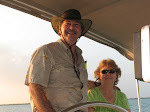April 21, 2009
The Houma docks were at an intersection of the intracoastal waterway and a small canal. The docks were located on the north side of the intracoastal waterway. The canal and the waterway effectively made a cross. That’s important because I took this opportunity to practice backing this boat. There was a little wind and I tried backing from three separate directions of the cross. The waterway was not busy so I was able to practice without damaging anything.
This boat is weird. If you put it in reverse it wants go toward the port side even if the wheel is turned to starboard. The prop makes it move like this and adding power only makes it walk to port more. Needless to say, backing to starboard was not pretty. Then, the wind caught the bow (I was backing with the wind) and over it went. So, back into forward and turn downwind. This time, I back to port and the prop pushed to port along with the rudder, the boat backed fine. So, I guess I can only back into docks on my port side and only if the wind is behind me. After I practiced backing a little, we headed down the ICW.
About a mile away were the Retif fuel docks. It took a couple of tries to pull into their docks but we made it with little effort. The wind was tricky here. In the ICW it was blowing us toward the dock. As we got closer, it came on our nose and pushed us back from the dock. Anyway, we tied up, refueled and visited with the attendant. As we were leaving he said, "I sure wish I were going with you."
The trip from Houma to Morgan City is exceptionally beautiful. There is a wildlife refuge just outside Houma. The woods are cypress trees with their roots sticking up out of the water. Hyacinth was floating everywhere. At times it was fairly thick which concerned me about the water intake but evidently the boat took it well.
Morgan City is an industrial town with the shipping industry everywhere. There were large boat factories and hundreds of varieties of crew and work boats all along the Intracoastal Waterway. There is a lock just east of Morgan City and we spent an hour waiting to get through. When you get near you radio the lock and it puts you on a list for your turn. We waited in a large turning basin with factories all along one side.
Waiting means you have to move the boat to a spot, let it drift, move it back, let it drift. I practiced heaving to, just with no sails up. I would turn the boat so the wind hit if from the port side, the wind would push the nose to starboard, I’d then turn the rudder to port which pushed the nose against the wind. The boat just sat still with a little drift. Once I tired of heaving to, I started practicing backing up until I realized how stupid I must look sitting in front of these factories with all these work crews backing my boat to the left, the right, then forward, then back again.
Finally, the lock radioed and said to come through so off we went. We were the only boat in the lock and the drop was only about a foot as compared to nine feet or so in New Orleans. We left the lock and eased around toward the Morgan City Public Dock.
These towns along the ICW have public docks for those of us heading one way or the other. Houma’s was really nice. Morgan City’s was not as nice, not as protected, but free so who can complain. We pulled in the last remaining spot behind a twenty five to twenty eight foot sailboat with a large box on the back. The large box was painted with the scuba diving flag design. While we were tying up, a young guy came up. He was Fish, Captain Fish. That is not his real name, it was Frank, but everyone called him Fish. He was a great guy. He was laid off from his job. He had just left Pt. Arthur and he was headed east to Key West where he intends to find work and open a salvage business. I took that as he was going to look for treasure.
Fish brought over some ICW charts for the area and describe to us the trip from Morgan City to Pt. Arthur. He told us what we hoped was not correct–there is nothing between Intracoastal City and the Pt. Arthur area. That means about a 120 mile trip with no services whatsoever. We will have to anchor one night.
There is a small bump of a town called Gibbstown which I had hoped would have a place to stay, but it doesn’t he said. So, he told us about a couple of anchorages and that is what we will be doing tomorrow night. We need to go approximately eighty miles to the anchorage though so we will get up extra early that morning, leave before daylight, and try to get to the anchorage before dark. I hope the winds are favorable so we can sail.
Post again tomorrow
Royal Crescent.
Friday, April 24, 2009
Subscribe to:
Post Comments (Atom)

No comments:
Post a Comment